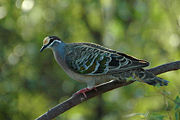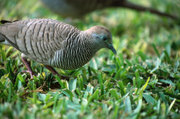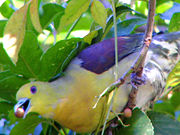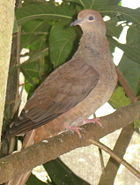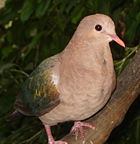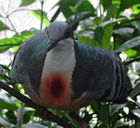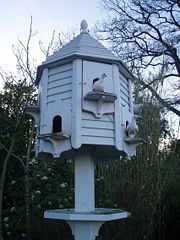Columbidae
2008/9 Schools Wikipedia Selection. Related subjects: Birds
| Pigeons and Doves Fossil range: Early Miocene - Recent |
||||||||||
|---|---|---|---|---|---|---|---|---|---|---|
 Feral Pigeon (Columba livia domestica) in flight
|
||||||||||
| Scientific classification | ||||||||||
|
||||||||||
| Subfamilies | ||||||||||
|
see article text |
Pigeons and doves constitute the family Columbidae within the order Columbiformes, which include some 300 species of near passerine birds. In general parlance the terms "dove" and "pigeon" are used somewhat interchangeably. In ornithological practice, there is a tendency for "dove" to be used for smaller species and "pigeon" for larger ones, but this is in no way consistently applied, and historically the common names for these birds involve a great deal of variation between the term "dove" and "pigeon." This family occurs worldwide, but the greatest variety is in the Indomalaya and Australasia ecozones. The young doves and pigeons are called "squabs."
Pigeons and doves are stout-bodied birds with short necks and short slender bills with a fleshy cere. The species commonly referred to just as the "pigeon" is the feral Rock Pigeon, common in many cities.
Their usually flimsy nests are made of sticks, and the two white eggs are incubated by both sexes. Doves feed on seeds, fruit and plants. Unlike most other birds (but see flamingo), the doves and pigeons produce " crop milk," which is secreted by a sloughing of fluid-filled cells from the lining of the crop. Both sexes produce this highly nutritious substance to feed to the young.
Biology
Morphology
The pigeons and doves exhibit considerable variation in size. The largest species are the crowned pigeons of New Guinea, which can weigh up to 2000 g, the smallest species is the new World Common Ground-dove, which is the same size as a House Sparrow and weighs only 30g. The largest arboreal species are the imperial-pigeons like the New Caledonian Imperial-pigeon and the Kereru of New Zealand. Smaller species tend to be known as doves, and larger species as pigeons, but there is no taxonomic basis for distinguishing between the two.
Overall, the Columbidae tend to have short bills and legs, small heads on large compact bodies. The wings are large and have low wing loadings; pigeons have strong wing muscles (wing muscles comprise 31-44% of their body weight) and are amongst the strongest fliers of all birds. They are also highly manoeuvrable in flight.
The plumage of the family is variable. Granivorous species tend to have dull plumage, with a few exceptions, whereas the frugivorous species have brightly coloured plumage. The Ptilinopus fruit-doves are some of the brightest coloured pigeons, with the three endemic species of Fiji and the Indian Ocean Alectroenas being amongst the brightest coloured. Pigeons and doves may be sexually monochromatic or dichromatic. In addition to bright colours pigeons may sport crests or other ornamentation.
Distribution and habitat
The pigeons and doves are distributed everywhere on Earth except for the driest areas of the Sahara Desert, Antarctica and its surrounding islands and the high Arctic. They have colonised most of the world's oceanic islands (with the notable exception of Hawaii), reaching eastern Polynesia and the Chatham Islands in the Pacific, Mauritius, the Seychelles and Reunion in the Indian Ocean, and the Azores in the Atlantic Ocean.
The family has adapted to most of the habitats available on the planet. The largest number of species are found in tropical forests and woodlands, where they may be arboreal, terrestrial or semi-terrestrial. Various species also inhabit savannas, grasslands, deserts, temperate woodlands and forests, mangrove forests, and even the barren sands and gravels of atolls.
Some species have large natural ranges. The Eared Dove ranges across the entirety of South America from Colombia to Tierra Del Fuego, the Eurasian Collared Dove has a massive (if discontinuous) distribution from Britain across Europe, the Middle East, India and China, and the Laughing Dove across most of sub-Saharan Africa as well as India and the Middle-east. Other species have a tiny restricted distribution, this is most common in island endemics. The Whistling Dove is endemic to the tiny island of Kadavu in Fiji, the Caroline Ground-dove is restricted to two islands, Truk and Pohnpei in the Caroline Islands and the Grenada Dove is restricted to Grenada in the Caribbean. Some continental species also have tiny distributions; for example the Black-banded Fruit-dove is restricted to a small area of the Arnhem Land of Australia, the Somali Pigeon is restricted to a tiny area of northern Somalia, and Bare-eyed Ground-dove is restricted to the area around Salta and Tucuman in northern Argentina.
The largest range of any species is that of the Rock Pigeon (formerly Rock Dove). The species had a large natural distribution from Britain and Ireland to northern Africa, across Europe, Arabia, Central Asia, India, the Himalayas and up into China and Mongolia. The range of the species increased dramatically upon domestication as the species went feral in cities around the world. The species is currently resident across most of North America, and has established itself in cities and urban areas in South America, sub-Saharan Africa, South East Asia, Japan, Australia and New Zealand. The species is not the only pigeon to have increased its range due to actions of man, several other species have become established outside of their natural range after escaping captivity, and other species have increased their natural ranges due to habitat changes caused by human activities.
Diet
Seeds and fruit form the major component of the diet of pigeons and doves. In fact, the family can be divided into the seed eating or granivorous species (subfamily Columbinae) and the fruit eating or frugivorous species (the other four subfamilies). The granivorous typically feed on seed found on the ground, whereas the species that feed on fruit and mast tend to feed in trees. There are morphological adaptations that can be used to distinguish between the two groups, granivorous species tend to have thick walls in the gizzards, whereas the frugivores tend to have thin walls. In addition fruit eating species have short intestines whereas those that eat seeds have longer ones. Frugivores are capable of clinging to branches and even hang upside down in order to reach fruit.
In addition to fruit and seeds a number of other food items are taken by many species. Some species, particularly the ground-doves and quail-doves take a large number of prey items such as insects and worms. One species, the Atoll Fruit-dove is specialised in taking insect and reptile prey. Snails, moths and other insects are taken by White-crowned Doves, Orange Doves and Ruddy Ground Doves.
Systematics and evolution
This family is a highly coherent group with no members showing obvious links with other bird families, or vice versa. The dodo and solitaires are clearly related, as discussed below, but equally lacking in obvious links with other bird families. The limited fossil record also consists only of unequivocal Columbidae species. Links to the sandgrouse and parrots have been suggested, but resemblances to the first group are due to convergent evolution and the second depend on the parrot-like features of the Tooth-billed Pigeon. However, the distinctive features of that bird seem to have arisen from its specialized diet rather than a real relationship to the parrots.
The family is usually divided into five subfamilies, but this is probably inaccurate. For example, the American ground and quail doves which are usually placed in the Columbinae seem to be two distinct subfamilies. The order presented here follows Baptista et al. (1997) with some updates (Johnson & Clayton 2000, Johnson et al. 2001, Shapiro et al. 2002).
Note that the arrangement of genera and naming of subfamilies is in some cases provisional because analyzes of different DNA sequences yield results that differ, often radically, in the placement of certain (mainly Indo-Australian) genera. This ambiguity, probably caused by Long branch attraction, seems to confirm that the first pigeons evolved in the Australasian region, and that the "Treronidae" and allied forms (crowned and pheasant pigeons, for example) represent the earliest radiation of the group.
As the Dodo and Rodrigues Solitaire are in all likelihood part of the Indo-Australian radiation that produced the 3 small subfamilies mentioned above with the fruit-doves and -pigeons (including the Nicobar Pigeon), they are here included as a subfamily Raphinae, pending better material evidence of their exact relationships.
Exacerbating these issues, columbids are not well represented in the fossil record. No truly primitive forms have been found to date. The genus Gerandia which most likely belongs to the Columbinae has been described from Early Miocene deposits of France. Fragmentary remains of an indeterminate (probably "treronine") Early/ Middle Miocene pigeon were found in New Zealand. Apart from that, all other fossils belong to extant genera. For these, and for the considerable number of more recently extinct prehistoric species, see the respective genus accounts.
A list of all the species, sortable by common and scientific name, is at list of Columbidae species
Subfamily Columbinae - typical pigeons & doves
Genus Columba including Aplopelia - Old World pigeons (33-34 living species, 2-3 recently extinct)
Genus Streptopelia including Stigmatopelia and Nesoenas - turtledoves (14-18 living species)
Genus Patagioenas - American pigeons; formerly included in Columba (17 species)
Genus Macropygia (10 species)
Genus Reinwardtoena (3 species)
Genus Turacoena (2 species)
Subfamily N.N. - Bronzewings and relatives
Genus Turtur - African wood-doves (5 species; tentatively placed here)
Genus Oena - Namaqua Dove (tentatively placed here)
Genus Chalcophaps (2 species)
Genus Henicophaps (2 species)
Genus Phaps (3 species)
Genus Ocyphaps - Crested Pigeon
Genus Geophaps (3 species)
Genus Petrophassa - rock-pigeons (2 species)
Genus Geopelia (3-5 species)
Subfamily Leptotilinae - Zenaidine and quail-doves
Genus Zenaida
- White-winged Dove, Zenaida asiatica
- Pacific Dove, Zenaida meloda
- Zenaida Dove, Zenaida aurita
- Galapagos Dove, Zenaida galapagoensis
- Eared Dove, Zenaida auriculata
- Mourning Dove, Zenaida macroura
- Socorro Dove, Zenaida graysoni ( extinct in the wild)
Genus Ectopistes - Passenger Pigeon (extinct; 1914)
Genus Leptotila
- White-tipped Dove, Leptotila verreauxi
- White-faced Dove, Leptotila megalura
- Grey-fronted Dove, Leptotila rufaxilla
- Grey-headed Dove, Leptotila plumbeiceps
- Pallid Dove, Leptotila pallida
- Brown-backed Dove, Leptotila battyi
- Grenada Dove, Leptotila wellsi
- Caribbean Dove, Leptotila jamaicensis
- Grey-chested Dove, Leptotila cassini
- Ochre-bellied Dove, Leptotila ochraceiventris
- Tolima Dove, Leptotila conoveri
Genus Geotrygon - quail-doves
- Purplish-backed Quail-dove, Geotrygon lawrencii
- Veracruz Quail-dove, Geotrygon carrikeri
- Costa Rica Quail-dove, Geotrygon costaricensis
- Russet-crowned Quail-dove, Geotrygon goldmani
- Sapphire Quail-dove, Geotrygon saphirina
- Grey-headed Quail-dove, Geotrygon caniceps
- Hispaniolan Quail-dove, Geotrygon (caniceps) leucometopius
- Crested Quail-dove, Geotrygon versicolor
- Rufous-breasted Quail-dove, Geotrygon chiriquensis
- Olive-backed Quail-dove, Geotrygon veraguensis
- White-faced Quail-dove, Geotrygon albifacies
- Lined Quail-dove, Geotrygon linearis
- White-throated Quail-dove, Geotrygon frenata
- Key West Quail-dove, Geotrygon chrysia
- Bridled Quail-dove, Geotrygon mystacea
- Violaceous Quail-dove, Geotrygon violacea
- Ruddy Quail-dove, Geotrygon Montana
Genus Starnoenas
- Blue-headed Quail-dove, Starnoenas cyanocephala
Subfamily Columbininae - American ground doves
Genus Columbina
- Common Ground Dove, Columbina passerina
- Plain-breasted Ground Dove, Columbina minuta
- Ecuadorian Ground Dove, Columbina buckleyi
- Ruddy Ground Dove, Columbina talpacoti
- Picui Dove, Columbina picui
- Croaking Ground Dove, Columbina cruziana
- Blue-eyed Ground Dove, Columbina cyanopis
Genus Claravis
- Blue Ground Dove, Claravis pretiosa
- Purple-winged Ground Dove, Claravis godefrida
- Maroon-chested Ground-dove, Claravis mondetoura
Genus Metriopelia
- Bare-faced Ground Dove, Metriopelia ceciliae
- Moreno's Ground Dove, Metriopelia morenoi
- Black-winged Ground Dove, Metriopelia melanoptera
- Golden-spotted Ground Dove, Metriopelia aymara
Genus Scardafella - possibly belongs into Columbina
- Inca Dove, Scardafella inca
- Scaled Dove, Scardafella squammata
Genus Uropelia
- Long-tailed Ground Dove, Uropelia campestris...
Subfamily N.N. - Indopacific ground doves
Genus Gallicolumba (16-17 living species, 3-4 recently extinct)
- Luzon Bleeding-heart, Gallicolumba luzonica
- Mindanao Bleeding-heart, Gallicolumba crinigera (criniger is a spelling error in the description)
- Mindoro Bleeding-heart, Gallicolumba platenae
- Negros Bleeding-heart, Gallicolumba keayi
- Sulu Bleeding-heart, Gallicolumba menagei - possibly extinct (late 1990s?)
- Cinnamon Ground-dove, Gallicolumba rufigula
- Sulawesi Ground-dove, Gallicolumba tristigmata
- White-breasted Ground-dove, Gallicolumba jobiensis
- Norfolk Island Ground-dove, Gallicolumba norfolciensis - extinct (c.1800)
- White-throated Ground-dove, Gallicolumba xanthonura
- Rota Ground Dove, Gallicolumba sp. - prehistoric
- Caroline Islands Ground-dove, Gallicolumba kubaryi
- Polynesian Ground-dove, Gallicolumba erythroptera
- Great Ground-dove, Gallicolumba nui - prehistoric
- Henderson Island Ground-dove, Gallicolumba leonpascoi - prehistoric
- New Caledonian Ground-dove, Gallicolumba longitarsus - prehistoric
- Shy Ground-dove, Gallicolumba stairi
- Santa Cruz Ground-dove, Gallicolumba sanctaecrucis
- Tanna Ground-dove, Gallicolumba ferruginea - extinct (late 18th-19th century)
- Thick-billed Ground-dove, Gallicolumba salamonis - extinct (mid-20th century)
- Marquesan Ground-dove, Gallicolumba rubescens
- Bronze Ground-dove, Gallicolumba beccarii
- Palau Ground-dove, Gallicolumba canifrons
- Wetar Ground-dove, Gallicolumba hoedtii
Genus Trugon
- Thick-billed Ground Pigeon, Trugon terrestris
Subfamily Otidiphabinae - Pheasant Pigeon
Genus Otidiphaps - Pheasant Pigeon
Subfamily Didunculinae - Tooth-billed Pigeon
Genus Didunculus
- Tooth-billed Pigeon, Didunculus strigirostris
- Tongan Tooth-billed Pigeon, Didunculus placopedetes - prehistoric
Subfamily Gourinae - crowned pigeons
Genus Goura (3 species)
- Western Crowned Pigeon, Goura cristata
- Southern Crowned Pigeon, Goura scheepmakeri
- Victoria Crowned Pigeon, Goura victoria
Subfamily N.N. ("Treroninae") - green and fruit-doves and imperial pigeons
Genus Ducula - imperial-pigeons
- Pink-bellied Imperial Pigeon, Ducula poliocephala
- White-bellied Imperial Pigeon, Ducula forsteni
- Mindoro Imperial Pigeon, Ducula mindorensis
- Grey-headed Imperial Pigeon, Ducula radiata
- Grey-necked Imperial Pigeon, Ducula carola
- Green Imperial Pigeon, Ducula aenea
- White-eyed Imperial Pigeon, Ducula perspicillata
- Blue-tailed Imperial Pigeon, Ducula concinna
- Pacific Imperial Pigeon, Ducula pacifica
- Micronesian Imperial Pigeon, Ducula oceanica
- Polynesian Imperial Pigeon, Ducula aurorae
- Nukuhiva Imperial Pigeon, Ducula galeata
- Red-knobbed Imperial Pigeon, Ducula rubricera
- Spice Imperial Pigeon, Ducula myristicivora
- Purple-tailed Imperial Pigeon, Ducula rufigaster
- Cinnamon-bellied Imperial Pigeon, Ducula basilica
- Finsch's Imperial Pigeon, Ducula finschii
- Shining Imperial Pigeon, Ducula chalconota
- Island Imperial Pigeon, Ducula pistrinaria
- Pink-headed Imperial Pigeon, Ducula rosacea
- Christmas Imperial Pigeon, Ducula whartoni
- Grey Imperial Pigeon, Ducula pickeringii
- Peale's Imperial Pigeon, Ducula latrans
- Chestnut-bellied Imperial Pigeon, Ducula brenchleyi
- Vanuatu Imperial Pigeon, Ducula bakeri
- New Caledonian Imperial Pigeon, Ducula goliath
- Pinon's Imperial Pigeon, Ducula pinon
- Bismarck Imperial Pigeon, Ducula melanochroa
- Collared Imperial Pigeon, Ducula mullerii
- Zoe's Imperial Pigeon, Ducula zoeae
- Mountain Imperial Pigeon, Ducula badia
- Dark-backed Imperial Pigeon, Ducula lacernulata
- Timor Imperial Pigeon, Ducula cineracea
- Pied Imperial Pigeon, Ducula bicolor
- Torresian Imperial Pigeon, Ducula spilorrhoa
- White Imperial Pigeon, Ducula luctuosa
Genus Lopholaimus - Topknot Pigeon
Genus Hemiphaga
- Kererū Hemiphaga novaseelandiae
- Parea Hemiphaga chathamensis
Genus Cryptophaps
- Sombre Pigeon, Cryptophaps poecilorrhoa
Genus Gymnophaps - mountain-pigeons
- Papuan Mountain-pigeon Gymnophaps albertisii
- Long-tailed Mountain-pigeon Gymnophaps mada
- Pale Mountain-pigeon Gymnophaps solomonensis
Genus Ptilinopus - fruit-doves (some 50 living species, 1-2 recently extinct)
Genus Natunaornis - Viti Levu Giant Pigeon ( prehistoric)
Genus Drepanoptila
- Cloven-feathered Dove, Drepanoptila holosericea
Genus Alectroenas - blue pigeons
- Madagascar Blue Pigeon, Alectroenas madagascariensis
- Comoro Blue Pigeon, Alectroenas sganzini
- Seychelles Blue Pigeon, Alectroenas pulcherrima
- Farquhar Blue Pigeon, Alectroenas sp. (extinct)
- Mauritius Blue Pigeon, Alectroenas nitidissima (extinct)
- Rodrigues Pigeon "Alectroenas" rodericana (extinct; probably distinct genus)
Subfamily Raphinae - didines
Genus Raphus - Dodo (extinct; late 17th century)
Genus Pezophaps - Rodrigues Solitaire (extinct; c. 1730)
Placement unresolved
Genus Caloenas
- Nicobar Pigeon, Caloenas nicobarica
- Greater Maned Pigeon, Caloenas canacorum ( prehistoric)
- Liverpool Pigeon, "Caloenas" maculata - extinct; probably distinct genus
Genus Treron - green pigeons
- Cinnamon-headed Green Pigeon, Treron fulvicollis
- Little Green Pigeon, Treron olax
- Pink-necked Green Pigeon, Treron vernans
- Orange-breasted Green Pigeon, Treron bicincta
- Pompadour Green Pigeon, Treron pompadora
- Thick-billed Green Pigeon, Treron curvirostra
- Grey-cheeked Green Pigeon, Treron griseicauda
- Sumba Green Pigeon, Treron teysmannii
- Flores Green Pigeon, Treron floris
- Timor Green Pigeon, Treron psittacea
- Large Green Pigeon, Treron capellei
- Yellow-footed Green Pigeon, Treron phoenicoptera
- Bruce's Green Pigeon, Treron waalia
- Madagascar Green Pigeon, Treron australis
- African Green Pigeon, Treron calva
- Pemba Green Pigeon, Treron pembaensis
- Sao Tome Green Pigeon, Treron sanctithomae
- Pin-tailed Green Pigeon, Treron apicauda
- Sumatran Green Pigeon, Treron oxyura
- Yellow-vented Green Pigeon, Treron seimundi
- Wedge-tailed Green Pigeon, Treron sphenura
- White-bellied Green Pigeon, Treron sieboldii
- Whistling Green Pigeon, Treron formosae
Genus Phapitreron - brown doves
- White-eared Brown Dove, Phapitreron leucotis
- Amethyst Brown Dove, Phapitreron amethystina
- Dark-eared Brown Dove, Phapitreron cinereiceps
Genus Leucosarcia - Wonga Pigeon
Genus Microgoura - Choiseul Crested Pigeon (extinct; early 20th century)
Genus Dysmoropelia
- St Helena Dove, Dysmoropelia dekarchiskos (extinct)
Genus indeterminate
- Henderson Island Archaic Pigeon, Columbidae gen. et sp. indet. ( prehistoric)
Relationship with humans
Doves as food
Several species of pigeon or dove are used as food, and probably any could be; the powerful breast muscles characteristic of the family make excellent meat. In Europe the Wood Pigeon is commonly shot as a game bird, while Rock Pigeons were originally domesticated as a food species, and many breeds were developed for their meat-bearing qualities. The extinction of the Passenger Pigeon was at least partly due to shooting for use as food.
Doves in religion
According to the Tanakh, doves are kosher, and they are the only birds that may be used for a korban. Other kosher birds may be eaten, but not brought as a korban. In the New Testament a dove is the symbol of the Holy Spirit.
Threats and conservation
While many species of pigeons and doves have benefited from human activities and have increased their ranges, many other species have declined in numbers and some have become threatened or even succumbed to extinction. Amongst the 10 species that have become extinct since 1600 (the conventional date for estimating modern extinctions) are two of the most famous extinct species, the Dodo and the Passenger Pigeon. The Passenger Pigeon was exceptional for a number of reasons, along with being the only pigeon species to have gone extinct in modern times that was not an island species it was once the most numerous species of bird on Earth. Its former numbers are difficult to estimate but one ornithologist, Alexander Wilson, estimated that one flock he observed contained over two billion birds. The decline of the species was abrupt; in 1871 a breeding colony was estimated to contain over a hundred million birds, yet the last individual in the species was dead by 1914. Although habitat loss was a contributing factor, the species is thought to have been massively overhunted, being used as food for slaves and, later, the poor in the United States throughout the 19th century.
The Dodo, and its extinction, was more typical of the extinctions of pigeons in the past. Like many species that colonize remote islands with few predators it lost much of its anti-predator behaviour, along with its ability to fly. The arrival of people, along with a suite of other introduced species such as rats, pigs and cats, quickly spelt the end for this species and all the other island forms that have become extinct.
Around 59 species of pigeon and dove are threatened with extinction today, this is 19% of all species. Most of these are tropical and live on islands. All of the species threatened today are threatened by introduced predators, habitat loss and hunting, or a combination of these factors. In some cases they may be extinct in the wild, as is the Socorro Dove of Socorro Island, Mexico, which was driven to the edge of extinction by habitat loss and introduced feral cats. In some areas a lack of knowledge means that the true status of a species is unknown; the Negros Fruit Dove has not been seen since 1953 and may or may not be extinct, and the Polynesian Ground-dove is classified as critically endangered as it is unknown whether it survives or not on remote islands in the far west of the Pacific Ocean.
Various conservation techniques are employed in order to prevent these extinctions. These include laws and regulations in order to control hunting pressure, the establishment of protected areas to prevent further habitat loss, the establishment of captive populations for reintroduction back into the wild ( ex situ conservation) and the translocation of individuals to suitable habitat to create additional populations.

